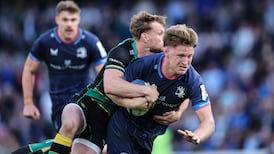The implications of last Friday's decision by the FAI to row in iwith the Government's plan for a national stadium has left many of the clubs a little preoccupied.
Few of the 22 are short of plans, schemes, models or artists' impressions of how their glorious ground could look some day. The reality is, though, that just about all have been desperately short of funds down the years, and in one or two clubhouses it seems that even the framed pictures of neat little 6,000 to 10,000 seat stadiums look frayed. The chances are that over the weekend a few are getting dusted down and moved back into more prominent locations.
As he left the meeting where delegates from all over the country accepted the Government's funding package in return for changing horses, Athlone Town's Paddy McCaul's optimism about how the deal might affect his club was typical.
For the past few years Athlone have been working on a scheme to get out of St Mel's Park - a ground it is hard to imagine even Town's most dedicated supporters getting too misty-eyed about.
A deal, allowing for a ground swop, has been in place with Westmeath County Council for some time, and the club's directors have a 10-acre site at Clanbrusk, just off the bypass and right beside the new sports centre (complete with all-weather pitches) earmarked as their new home.
McCaul reckons that getting out there and completing the first phase of the development - the pitches and training area, a stand for 2,000 as well as some other spectator facilities - will cost some £1.5 million.
He recognises that the club itself will have to come up with a third of that which, he feels, is achievable by the target date for relocating, which is the summer of 2003. But before last week finding another £1 million from the Government and FAI would have seemed far-fetched. Now it should be a good deal more realistic.
Officials within the association insist that, as the new funding arrangements will be based on the old rules for obtaining grants, clubs themselves are going to have to "get their acts together" if they are really going to benefit. The incentives to do so are, however, very attractive indeed.
Up to now, clubs were, in most cases, obliged to come up with between 60 and 70 per cent of the money required to get a project completed. That figure should, on average, drop to something around the 35 to 40 per cent mark, with the balance provided by a combination of FAI and Government matching funds.
In designated areas around the country (there are more than 20, mainly in urban areas) the funding provided will be even greater, and in some of those areas schemes initiated by clubs could be fully funded from outside.
Such projects, as was repeatedly emphasised on Friday, need not necessarily be of the bricks and mortar variety, with coaching and development work set to be a high priority.
In Athlone, McCaul pays tribute to the work of Padraig Nicholson, the FAI's regional development officer, whose coaching work, he believes, provides a link between clubs at all levels of the game.
More will be appointed, while there are likely to be coaching centres in at least a couple of places outside Dublin.
The association, meanwhile, has recently completed a breakdown, between the senior and junior games, of where the grants they have made over the last 13 years have gone. The starting point, 1988, was chosen because it marked the first time the Republic qualified for a major championships and, therefore, the first time there were funds worth talking about to distribute.
The figures are small, with the National League clubs having received perhaps £6million during all of that time. In percentage terms, however, the 22 clubs obtained around 40 per cent of the grants disbursed. Such a share of the enormous funds to be drawn down over the next 13 years would have a huge affect on the league.
As it happens, the system laid down means that there will be no straight carve-up between the various sections of the game. But if the senior clubs can come up with the sort of projects that maximise the benefits of this deal, a similar percentage split between now and 2014 could turn a lot of league chairmen's dreams into reality.











